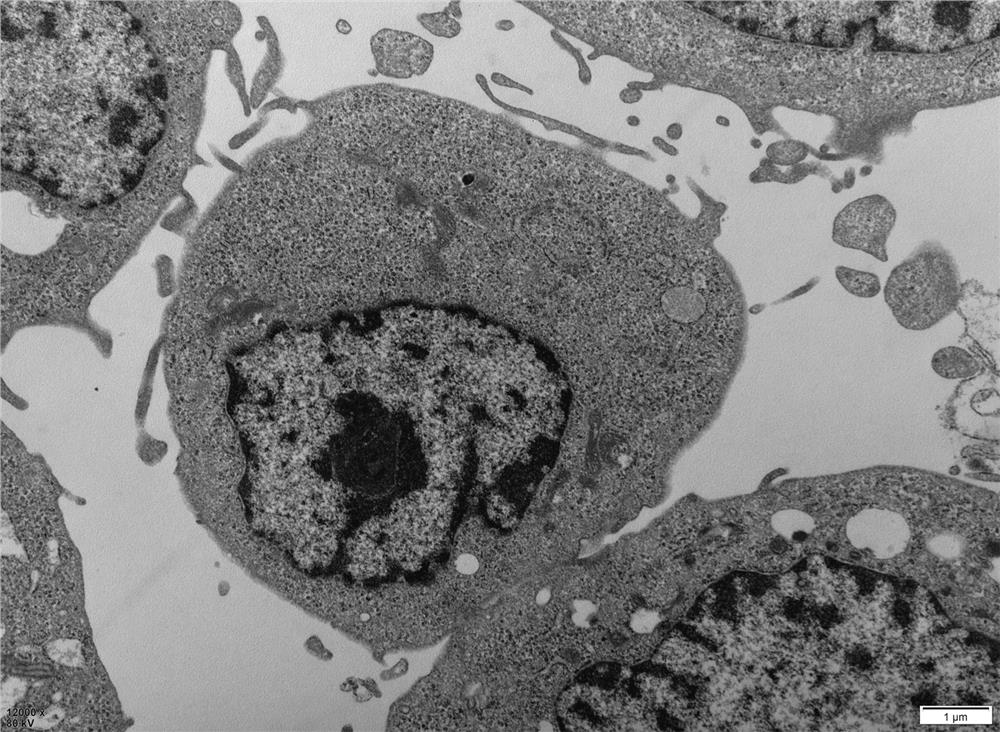Lymph node-derived lymphoma-related fibroblast tumor cell strain and application thereof
A fibroblast and lymphoma cell technology, applied in the field of biomedicine, can solve the problems of fibroblasts that have not been studied and reported
- Summary
- Abstract
- Description
- Claims
- Application Information
AI Technical Summary
Problems solved by technology
Method used
Image
Examples
Embodiment
[0027] Example: Isolation and establishment of HXLyAF-KLN
[0028] The HXLyAF-KLN described in this example is derived from the lymph node microenvironment in the human lymphoma cell transplanted tumor model in nude mice, and its cell name is mouse lymphoma-associated fibroblast tumor cell HXLyAF-KLN, and its construction method is as follows:
[0029] (1) The human anaplastic large cell lymphoma cells Karpas299 in logarithmic growth phase were divided into 8 × 10 6 Each mouse / 100µl / mouse was inoculated into male Balb / c (nu / nu) mice (8 weeks old, body weight 22-27g) subcutaneously in the nude area; the tumor formation at the inoculation site was observed every other day, and the mice did not form subcutaneous tumors. Weeks later, human anaplastic large cell lymphoma cells Karpas299 were pressed again by 3 × 10 6 Each / 200µl / mouse was inoculated subcutaneously in the nude area opposite to the previous inoculation site of mice. More than 30 days after the second inoculation, th...
Embodiment 2
[0035] Example 2: Growth and Biological Characterization of HXLyAF-KLN
[0036] (1) Cell morphology observation:
[0037] Take HXLyAF-KLN cells in logarithmic growth phase and observe the morphology of living cells under an inverted microscope, such as figure 1 As shown, the cells grow adherently, mainly irregular polygonal and spindle-shaped, with large nuclei, clear nucleoli, stubby protrusions in the cytoplasm, no contact inhibition, and can cross and overlap growth, and aggregate in clusters when cells are dense; 3 % glutaraldehyde was pre-fixed, 1% osmium tetroxide was re-fixed, uranyl acetate and lead citrate were stained with JEM-1400FLASH fluoroscopy electron microscope to observe the ultrastructure of cells, such as figure 2 It can be seen that the nucleus is irregular in shape, with notch, clear nuclear membrane, obvious nucleolus, increased cytoplasmic rough endoplasmic reticulum, abundant free ribosomes, endoplasmic reticulum, mitochondria and other organelles. ...
Embodiment 3
[0045] Example 3: Construction of mouse fibroblast tumor animal model
PUM
 Login to View More
Login to View More Abstract
Description
Claims
Application Information
 Login to View More
Login to View More - R&D
- Intellectual Property
- Life Sciences
- Materials
- Tech Scout
- Unparalleled Data Quality
- Higher Quality Content
- 60% Fewer Hallucinations
Browse by: Latest US Patents, China's latest patents, Technical Efficacy Thesaurus, Application Domain, Technology Topic, Popular Technical Reports.
© 2025 PatSnap. All rights reserved.Legal|Privacy policy|Modern Slavery Act Transparency Statement|Sitemap|About US| Contact US: help@patsnap.com



